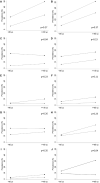Neuropathological lesions in the very old: results from a large Brazilian autopsy study
- PMID: 30861605
- PMCID: PMC6742578
- DOI: 10.1111/bpa.12719
Neuropathological lesions in the very old: results from a large Brazilian autopsy study
Abstract
Objective: To compare neuropathological correlates of cognitive impairment between very old and younger individuals from a Brazilian clinicopathological study.
Methods: We assessed the frequency of neuropathological lesions and their association with cognitive impairment (Clinical Dementia Rating scale ≥0.5) in the 80 or over age group compared to younger participants, using logistic regression models adjusted for sex, race and education.
Results: Except for infarcts and siderocalcinosis, all neuropathological lesions were more common in the 80 or over age group (n = 412) compared to 50-79 year olds (n = 677). Very old participants had more than twice the likelihood of having ≥2 neuropathological diagnoses than younger participants (OR = 2.66, 95% CI = 2.03-3.50). Neurofibrillary tangles, infarcts and hyaline arteriolosclerosis were associated with cognitive impairment in the two age groups. Siderocalcinosis was associated with cognitive impairment in the younger participants only, while Lewy body disease was associated with cognitive impairment in the very old only. In addition, we found that the association of infarcts and multiple pathologies with cognitive impairment was attenuated in very old adults (Infarcts: P for interaction = 0.04; and multiple pathologies: P = 0.05). However, the predictive value for the aggregate model with all neuropathological lesions showed similar discrimination in both age groups [Area under Receiver Operating Characteristic curve (AUROC) = 0.778 in younger participants and AUROC = 0.765 in the very old].
Conclusion and relevance: Despite a higher frequency of neuropathological findings in the very old group, as found in studies with high-income populations, we found attenuation of the effect of infarcts rather than neurofibrillary tangles and plaques as reported previously.
Keywords: 80 and over; Alzheimer’s disease; aged; dementia; neuropathology; vascular dementia; very old.
© 2019 International Society of Neuropathology.
Conflict of interest statement
None
Figures




Comment in
-
Anthropometric rather than ethnic factors may explain differences in the incidence of Alzheimer-type neurodegenerative changes.Brain Pathol. 2020 Jan;30(1):203. doi: 10.1111/bpa.12796. Brain Pathol. 2020. PMID: 31593322 Free PMC article. No abstract available.
-
Response letter: neuropathological lesions in the very old.Brain Pathol. 2020 Jan;30(1):204. doi: 10.1111/bpa.12795. Brain Pathol. 2020. PMID: 31596998 Free PMC article. No abstract available.
Similar articles
-
The Contribution of Cerebral Vascular Neuropathology to Mild Stage of Alzheimer's Dementia Using the NACC Database.Curr Alzheimer Res. 2020;17(13):1167-1176. doi: 10.2174/1567205018666210212160902. Curr Alzheimer Res. 2020. PMID: 33583381 Free PMC article.
-
Association Between Alcohol Consumption, Cognitive Abilities, and Neuropathologic Changes: A Population-Based Autopsy Study.Neurology. 2025 May 13;104(9):e213555. doi: 10.1212/WNL.0000000000213555. Epub 2025 Apr 9. Neurology. 2025. PMID: 40203226
-
Neuropathological diagnoses and clinical correlates in older adults in Brazil: A cross-sectional study.PLoS Med. 2017 Mar 28;14(3):e1002267. doi: 10.1371/journal.pmed.1002267. eCollection 2017 Mar. PLoS Med. 2017. PMID: 28350821 Free PMC article.
-
Association between APOE-ε4 allele and cognitive function is mediated by Alzheimer's disease pathology: a population-based autopsy study in an admixed sample.Acta Neuropathol Commun. 2023 Dec 19;11(1):205. doi: 10.1186/s40478-023-01681-z. Acta Neuropathol Commun. 2023. PMID: 38115150 Free PMC article. Review.
-
Neuropathological alterations in Alzheimer disease.Cold Spring Harb Perspect Med. 2011 Sep;1(1):a006189. doi: 10.1101/cshperspect.a006189. Cold Spring Harb Perspect Med. 2011. PMID: 22229116 Free PMC article. Review.
Cited by
-
Alzheimer's disease clinical variants show distinct regional patterns of neurofibrillary tangle accumulation.Acta Neuropathol. 2019 Oct;138(4):597-612. doi: 10.1007/s00401-019-02036-6. Epub 2019 Jun 27. Acta Neuropathol. 2019. PMID: 31250152 Free PMC article.
-
Study of neuropathological changes and dementia in 100 centenarians in The 90+ Study.Alzheimers Dement. 2023 Aug;19(8):3417-3425. doi: 10.1002/alz.12981. Epub 2023 Feb 16. Alzheimers Dement. 2023. PMID: 36795955 Free PMC article.
-
Anthropometric rather than ethnic factors may explain differences in the incidence of Alzheimer-type neurodegenerative changes.Brain Pathol. 2020 Jan;30(1):203. doi: 10.1111/bpa.12796. Brain Pathol. 2020. PMID: 31593322 Free PMC article. No abstract available.
-
Cerebral Small Vessel Disease, Hypertension, and Vascular Contributions to Cognitive Impairment and Dementia.Hypertension. 2024 Jan;81(1):75-86. doi: 10.1161/HYPERTENSIONAHA.123.19943. Epub 2023 Nov 29. Hypertension. 2024. PMID: 38044814 Free PMC article. Review.
-
Is Alzheimer disease a disease?Nat Rev Neurol. 2024 Apr;20(4):245-251. doi: 10.1038/s41582-024-00940-4. Epub 2024 Feb 29. Nat Rev Neurol. 2024. PMID: 38424454 Free PMC article. Review.
References
-
- Alzheimer's Association (2017) 2017 Alzheimer's disease facts and figures. Alzheimer's Dementia 13:325–373.
-
- Braak H, Braak E (1989) Cortical and subcortical argyrophilic grains characterize a disease associated with adult onset dementia. Neuropathol Appl Neurobiol 15:13–26. - PubMed
-
- Braak H, Braak E (1991) Neuropathological staging of Alzheimer‐related changes. Acta Neuropathologica 82:239–259. - PubMed
-
- Braak H, Del Tredici K, Rub U, de Vos RA, Jansen Steur EN, Braak E (2003) Staging of brain pathology related to sporadic Parkinson's disease. Neurobiol Aging 24:197–211. - PubMed

